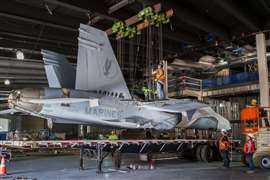Good as new
01 April 2008
The current boom in demand for cranes is affecting the whole industry, not least the repair and refurbishment sector. Such companies are taking on ever more work from operators desperate to keep their aging machines working or to repair their damaged ones.
Ruud Schreijer from Rusch Kraantechniek in the Netherlands says the company repairs more than 300 cranes a year. They range from very small jobs to the replacement of complete boom sections, cabins, upper-structures and carriers, mainly on Liebherr, Demag, Faun and Grove machines.
“The economy is going up and the request for machines is more than the manufacturers can produce. Delivery time for new machinery has gone up, sometimes two years. Damaged cranes are, therefore, more often repaired.”
Schreijer adds that the decision to repair a crane, or not, often comes down to cost, which is why, he says, manufacturers often state that a repair is not possible.
“Specialized repair companies often know more about repairing the booms than the manufacturers themselves. When welding a telescopic boom section a manufacturer is welding in the neutral line. When we repair a part of the boom section we are also welding in the stressed area. Excessive tests and studies have taught us how to do that without losing static or dynamic characteristics of the material,” Schriejer explains.
Time and cost
The amount of time needed is also a major factor in the decision to repair or buy new. “Repair is often cheaper but certainly not always. If the required equipment is in stock you could decide to pay for instant availability. If the machine or component is not in stock, a repair or refurbishment is often faster but may be more expensive. It depends what is important for the customer at that moment – time, money or both,” adds Schreijer.
The long lead times for new equipment quoted by manufactures can even mean cranes once condemned to the scrap yard are now considered for refurbishment, Schreijer continues. “Nowadays, with the scarcity of new cranes it may be still economical to repair it anyway, even if for insurers the crane is a total loss. This depends, of course, on make, type and year of fabrication – not older than five years.”
Koehler Kran Service, in Germany, repairs mobile cranes that have suffered all levels of damage. Company owner Andreas Koehler agrees that global demand for repair and refurbishment services is getting stronger. “Because of long delivery times damaged machines get repaired and older machines get refurbished.” Although he forecasts the company's 50-50 split between domestic and export work will remain the same.
Costly parts
The repair and refurbishment industry has also been affected by component supply problems. Component manufacturers are facing their own struggle to keep up supplies, says Koehler. “We have problems like every other company. You get longer delivery times and higher prices for base materials, especially for spare parts from the manufacturer.”
The problem, however, Koehler says, is not having much effect on the turnaround time for his company. And he adds that the cranes Koehler Kran is being asked to repair are not getting older as a result of the extended lead times.
Glenn Windhouwer of Avezaat Cranes, based in The Netherlands, has found that long delivery times from manufacturers is extending the lifecycle of mobile cranes. Windhouwer adds that another distinct sector trend is the increase in use of high quality materials and refined technologies for repairs and new build projects. “This demands such a level of knowledge and resources that the work is virtually only carried out by a select group. It also means that the quality of the repaired equipment is not inferior in any way from new equipment.”
Jay Shiffler at repair and restoration specialist Wheco Corporation in the US says that in the current climate customers are taking full advantage of the company's SLEP programme (Service Life Extension Projects).
“The worldwide demand for cranes and the resulting shortage has increased the demand for the availability of existing machinery. Customers are looking to have their accident-damaged cranes put back into service in the most time- and cost-effective manner. And customers are also looking to try to extend the service life of their older and aging cranes.”
Wheco works on all types of cranes but Shiffler says mobile cranes, including all terrains, truck and rough terrain types, are the most regularly seen in for repair.
“Because these are mobile cranes, many of the accidents are not just job site or lifting related but simply the result of street and highway accidents.”
The company also carries out extensive work on crawler cranes, which, Shiffler adds, are excellent candidates for repair and SLEP because of their long service life.
Race against time
“Too often the long time and high cost associated with replacing damaged structural parts and components gives reason to send a unit to salvage. But engineered structural repairs are our core business which gives us the ability to take even the most heavily damaged crane and put it back into generating revenue in the most cost-effective manner.”
In assessing a potential repair or restoration job Wheco tries to measure the cost against the estimated actual cash value (ACV) or market value of the crane. “But it is interesting that in today's market, some customers are willing to pay more for a repair or restoration if it will put the crane back into revenue generating service faster than waiting for a new machine or long lead-time repair parts.”
Shiffler adds that with manufacturers running at full capacity, it may not just be the price of the part that puts customers off, but the basic availability of it. Wheco, he says, has the expertise to repair those items. “Further, with the capabilities of our full service shops, we can actually fabricate and build long lead time and obsolete piece parts and components that otherwise would delay getting a crane back into service.”
Overload
Some manufactures also offer a complete crane repair and refurbishment service but find themselves facing the same issues as the independent refurbishment companies. Terex Demag has a repair shop at its Zweibrücken factory in Germany. Christian Schorr-Golsong, marketing director Europe, says, “We do all kinds of repairs on cranes, in most cases in the yard of the customer, due to our highly international business.”
Most site repairs are related to damaged steel parts and worn out components, explains Schorr-Golsong, while the majority of the work in the repair shop is more structural, “due to intense use of the cranes, which, sometimes, leads to an overload.”
The decision whether to repair the crane or buy a new one remains with the customer but, in the current climate, the choice is often made for them. “Long delivery times lead to an increase in repairs because the demand for cranes in the market is still high and job sites have to be served. Of course the cost of the repair is linked to the cost we have for spare parts and also the parts for production, and here price increases are given by the suppliers,” explains Schorr-Golsong.
In 2007 Liebherr completed a new facility for reconditioning used cranes at its mobile and crawler crane factory at Ehingen in Germany. It has two similar facilities in Berlin and Oberhausen. The manufacturer also has reconditioning workshops in France, the US and the UK.
Three levels
Wolfgang Beringer at Liebherr-Werk Ehingen explains that demand is strong across the lifting capacity spectrum. “There is no specific type of machine especially required. There is a good market for smaller cranes, as well as for bigger ones. Moreover, at present, the market for older cranes, as well as for younger ones, is good.”
The factory offers three categories of used crane – actual condition, partially overhauled and fully overhauled at the factory. “We perform the work according to our customers' needs. The more precise information the buyer provides about their requested used one, the better we will be able to offer a suitable crane,” adds Beringer.
For those requiring a quick delivery, the crane will simply undergo an examination before it is shipped out in “actual condition,” with a report. A partially overhauled crane is operational and ready for work. Inspections of the carrier and the superstructure will have been carried out and it will have passed the German TÜV, or a similar standard in another country. Depending on the age of the crane, says Beringer, an EC quality certificate is also possible.
Lastly, the ‘overhauled at the factory' option offers a complete service, in which the crane is refurbished to the last detail. “All assemblies, the condition of which could impair operation on a long-term basis, will be overhauled or replaced by new or rebuilt parts. Upon completion of the overhaul, the equipment is examined and tested by us just like a new crane,” adds Beringer.
Strict safety
Tight safety standards are now a major issue in the refurbishment sector. “If a repair is done in the proper way there are no safety implications. A good repair is as strong as the original,” comments Ruud Schreijer at Rusch. He explains that all repairs come with a 12 month warranty.
“As we take care that the crane is not altered during the repair, there is no reason that the position of the original certification is endangered,” Schreijer says. The repair is simply recorded in the crane logbook and documented with a repair report stating all the relevant information.
“Well-repaired cranes and parts are in no way inferior to new,” says Windhouwer, “This also applies to safety. A full guarantee is given. Every certificate endorsed by well-known testing bodies, for example, Aboma, Keboma, SGS, DNV, AIB, RTD Lloyds can be issued.”
Safety is a vital consideration with most repairs, Schorr-Golsong says, which are based on the same standards used on new product Terex Demag production lines and come with a 12 month warranty. “We work closely with insurance companies, evaluators and other third parties together. Quality of the work is essential. We, as a manufacturer of mobile cranes, put our name to this.”
Soncino at HIT says its repair work is covered by CE regulations, as long as the structure is not modified and the speed and load capacities remain the same. “Sometimes a third party is involved to certify the crane, usually a third party – not the owner and not the repairer. If the destination of use is changed or the structure modified we repeat the structure calculation with an engineering company.”
Full guarantee
At Wheco all work is documented and guaranteed to be compliant to all known OSHA, Cal-OHA, ANSI and AWS standards and regulations.
“The safety implications are that if you are going to perform structural and other related repair services is that you better know what you are doing and be prepared to stand behind your work. We offer full warranties for all our work and guarantee that our work will be certified by an independent third-party certifier. Wheco is also fully insured and bondable.”




